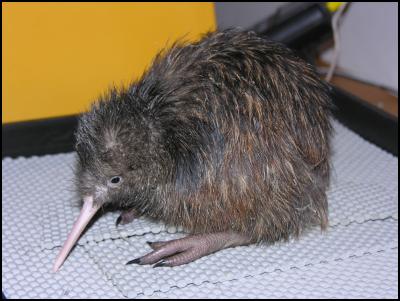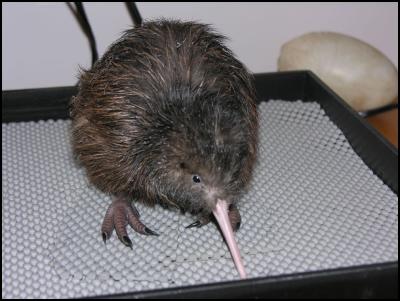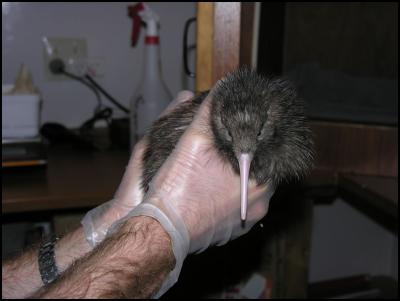Pukaha Kiwi Chick First For Forest In A Century
Pukaha Kiwi Chick First For Forest In A
Century

Click for big version
For the first time in over 100 years a kiwi chick conceived in the wild has hatched at Pukaha Mount Bruce.
The chick, which emerged from its egg yesterday, is the offspring of a male and female released into the Pukaha Mount Bruce forest in northern Wairarapa in December 2003. It was part of the Pukaha Restoration Project - a co-operative venture between the Department of Conservation (DOC), the National Wildlife Centre Trust, Rangitaane O Wairarapa, Greater Wellington Regional Council and Horizons Regional Council to restore the dawn chorus to the forest.
Reintroducing endangered species into the forest, such as kiwi, kaka and kokako, has been made possible through funding support from sponsors for predator control. The project has been supported over the next five years by DB Breweries, Tranzit Coachlines, Oldfields group, Trust House Ltd and W N Pharazyn Estate Charitable Trust. Kiwi recovery work in New Zealand is co-ordinated by the Bank of New Zealand Kiwi Recovery programme, managed by the DOC.

Click for big version

Click for big version
The kiwi egg, discovered by captive breeding staff at the Pukaha Mount Bruce National Wildlife Centre 10 weeks ago, was the only fertile egg of three produced by the same female, DOC biodiversity programme manager Geoff Underwood said.
After its discovery, staff carefully monitored its progress and, just prior to hatching, transferred it to a rearing facility to ensure a safe arrival. Egg and chick survival can be improved by up to 25 percent in captivity compared to in the wild.
“At this early stage of the programme, we wanted to maximise survival to ensure the population grows quickly” Mr Underwood said.
A further fertile egg discovered in the wild will also be taken into captivity and placed inside incubators in preparation for it hatching within the next fortnight.
This successful hatching follows the recent hatching of a chick to Pukaha Mount Bruce captive parents Rangi and Tua.
Mr Underwood said all the chicks would be fitted with chick sized transmitters and their progress in the first critical weeks and months of life monitored closely in captivity by their “adoptive” (DOC) parents.
“They will be released into the Pukaha Mount Bruce forest when they are strong enough to fend for themselves,” he said.
The wild kiwi pairs at Pukaha were introduced to each other well before their release into the Pukaha Mount Bruce forest, and their continued relationship does not appear to have been affected by their release. Mr Kiwi, transferred from Willowbank Wildlife Reserve in Christchurch, was released into the Pukaha Mount Bruce forest in December 2003. His mate is a female kiwi, also from Willowbank Wildlife Reserve, released on the same day as Mr Kiwi.
Manu Tapu has also stayed with his mate Kopa Kopa from Otorohanga Kiwi House. Manu Tapu and Kopa Kopa were released into the Pukaha Mount Bruce forest on 27 October, 2004.
The release of captive-reared kiwi into the wild in the southern North Island from where they became extinct over 100 years ago, was a first in the history of New Zealand. The discovery of a kiwi egg just months after the release, though infertile, marked another first.
The fact that there are now two pairs breeding bodes well for the future of this ground-breaking conservation effort, Department of Conservation Wairarapa area manager Derrick Field said.
“We are pleased to see that kiwi can adapt to a wild forest environment when transferred from captive breeding institutions. The Pukaha Restoration Project has proven that species can return to the mainland if pests are controlled at low levels.”
National Wildlife Centre chairman, John Bunny said he was delighted with the result.
“This proves the decision to restore the forest was the correct one. It makes all the hard work by those involved worthwhile. The pest control was underpinned by the funding support from our sponsors, which has been critical in ensuring the project succeeds over the long term.”
His sentiments were shared by Masterton mayor Bob Francis, who was ecstatic when he heard the news.
“This is fantastic news – it’s wonderful to see the results of all of our efforts come to fruition. This occasion highlights what can be achieved when the community, sponsors and local and central government all pull together for a common cause.”
Kiwi are vulnerable to many introduced predators, particularly stoats, during the first seven months of their lives. After they hatch, kiwi chicks spend up to three days consuming the yolk from their eggs to prepare them for their departure from the nest. After day three, kiwi leave the nest and they’re on their own in the world. Not surprisingly, the first few months of a young kiwi’s life are fraught with any number of natural problems as it fights to survive.
Recent human introductions such as stoats, ferrets, cats and dogs have compounded the problem. Currently only 5 percent of all kiwi chicks hatched in the wild survive for longer than three months. This is not a high enough number of birds to sustain the population. Just 50,000 North Island brown kiwi remain - largely in the top two-thirds of the North Island - which classifies them as ‘nationally vulnerable.’
ENDS


 Stats NZ: Total Greenhouse Gas Emissions Fall 0.7 Percent In The September 2024 Quarter
Stats NZ: Total Greenhouse Gas Emissions Fall 0.7 Percent In The September 2024 Quarter Takapuna Beach Business Association: Takapuna Outpaces Auckland With Strong Economic Growth In 2024
Takapuna Beach Business Association: Takapuna Outpaces Auckland With Strong Economic Growth In 2024 Commerce Commission: Bed, Bath And Beyond Sentenced Over Record Number Of Unsafe Products
Commerce Commission: Bed, Bath And Beyond Sentenced Over Record Number Of Unsafe Products GE Free NZ: Minister Reti Asked For Two Week Delay Of Select Committee Deadline
GE Free NZ: Minister Reti Asked For Two Week Delay Of Select Committee Deadline Science Media Centre: Government Plans To Double Mineral Exports By 2035 – Expert Reaction
Science Media Centre: Government Plans To Double Mineral Exports By 2035 – Expert Reaction University of Canterbury: AI-powered Tool To Combat Rising Wildfire Danger
University of Canterbury: AI-powered Tool To Combat Rising Wildfire Danger



